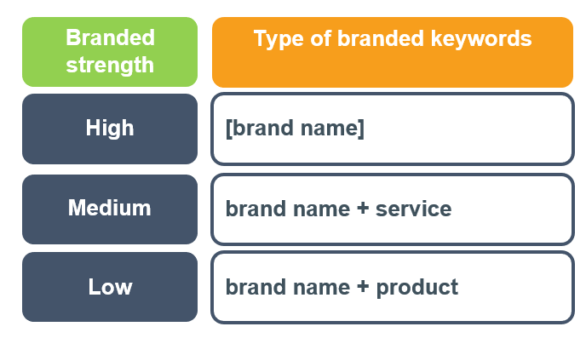There are 4 steps to evaluate your investment of branded keywords – judge performance then segment and calculate incrementality and adjust your targets based on that incrementality.
The question that is often asked: Should we invest in branded keywords?
However, the question we should ask: How much should we invest in branded keywords to have a positive incremental ROI?
In this article I will answer this question in 4 steps:
- How to judge the performance of your branded keywords
- How to segment your branded keywords
- How to calculate the incrementality of branded keywords
- Pulling it together: how to adjust your targets based on incrementality
There is a trend of rising ad spend on branded keywords because of growing competition, so it is ever more important to have a clear branded strategy.

Disclaimer: If your spend on branded keywords is quite low, then this approach is still very interesting, but you may not be able to get a good return on time spent in the short term.
1. How to judge the performance of your branded keywords
I would first like to stress the fundamental difference between branded and generic keywords, based on customer intent, performance, and strategic focus:

- Generic keywords: the user shows buying intent, but does not have a (declared) brand preference yet. The strategic purpose of paid search advertising is to acquire. This is where you get your additional sales and new customers.
- Branded keywords: the user is already searching for you. It is basically direct traffic. The strategic purpose of branded paid search is to defend. You are not getting additional sales or new clients, you are just making sure you don’t lose them to competitors or resellers.
These differences should also heavily impact how you judge performance:
- Branded keywords usually have a much better performance than generic keywords
- However, as mentioned above, these are not additional clicks and sales. The incrementality of branded keywords is much lower! Learn how to measure incrementality in this article.
How important it is to advertise on branded keywords varies between verticals and between advertisers. There are a number of factors that determine the importance of branded advertising:
- The top results on the SERP:
- Competitors: If you lose branded traffic to competitors, you will lose sales. This is specifically the case with semi-branded keywords (“brand name + product”).
- Resellers: other advertisers in the auction are sometimes resellers. They sell your products, but they may take part of the margin, or you may have to pay them a commission.
- (negative) News articles: news articles can potentially change a search query with a buying intent into a negative brand engagement.
- Customer journey:
- Branded advertising gives you more control over the customer journey. If you stop advertising, you might see that more traffic will go to Google features, like Google Maps, Google Flights, Google Hotel Ads etc. You have to think about how this will affect the customer journey. For example, if you are a retailer, which of these paths is more valuable?
- Google -> Website -> store visit
- Google -> Google Maps -> store visit
- Branded advertising gives you more control over the customer journey. If you stop advertising, you might see that more traffic will go to Google features, like Google Maps, Google Flights, Google Hotel Ads etc. You have to think about how this will affect the customer journey. For example, if you are a retailer, which of these paths is more valuable?
- Data:
- In the situation above (Google -> Google Maps -> Store Visit) we lose that data. So we lose insights, and it limits us in follow up options like remarketing. This has a certain business value, which you should take into account.
2. How to segment your branded keywords
The level of incrementality for branded keywords can vary greatly between keywords. Take the following two examples:
Example 1:

Example 2:

Example 1 has a lot more competition, both in Shopping and Search. As such, advertising has a much higher incremental value than in example 2.
So you don’t want to treat all your branded keywords the same. That’s why you should segment your branded keywords into multiple groups based on similar characteristics. For example, for a large advertiser with thousands of branded keywords, we grouped all the branded keywords by looking at:
- The competition on the keyword
- How strong their organic rankings are
Based on this, we created three segments of branded keywords:

These three segments have very different levels of incrementality. The next step is to determine the actual level of incrementality for each group.
3. How to calculate the incrementality of branded keywords
When we are talking about branded paid search keywords, we should be talking about incrementality. How many additional (incremental) clicks and sales are we getting compared to not advertising on these keywords.
To find out, you can do the typical on/off experiments. However, the goal of the experiment shouldn’t be to find out if you should turn branded keywords on or off; you want to find out the incrementality rate.
Examples of how to set up this kind of experiment can be found here:
- Should You Bid On A Keyword If You Rank Organically For That Term? by Brad Geddes
- Brand Ad Cannibalization: A Tale of Two Tests by George Michie
- If you haven’t yet done these kinds of experiments, it’s okay to use assumptions and estimations based on experiments of similar advertisers.
If you have done this type of experiment, you can calculate the incrementality rate. The incrementality rate is the percentage of the paid search clicks that are actually additional to search as a whole (organic search + paid search).
You can calculate the incrementality rate in the following way:
- Incremental clicks / Paid search clicks * 100%
Take the following situation:

In this situation, you measure 400 clicks for paid search. However, only 200 of those clicks are additional clicks to search as a whole (because 200 clicks were cannibalized from organic). This means that 50% of the paid search clicks are incremental.
In the example below, you can see how the incrementality rate impacts your performance. With an incrementality of 50%, it means that you actually get just half the clicks, leading to CPC’s and CPA’s that are twice as high.

Instead of calculating the incremental value over your results, you can also adjust your targets based on the incrementality. This approach might be more actionable in your day-to-day optimizations.
4. Pulling it together: how to adjust your targets based on incrementality
If you have segmented your branded keywords, you can calculate new targets. This is calculated in the following way:
- With a CPA target: CPA target X Incrementality rate
- With a ROAS target: ROAS target / Incrementality rate
Below you can find an example of how this is calculated with a CPA target:

As you can see, your CPA targets for your branded keywords are very different when you take incrementality into account. So in practice, branded keywords often have strong performance, but as you can see, the performance has to be very strong.
Based on your new targets for each segment, you can do bid management for your branded keywords. It will mean that you will not always claim the top position. But that is okay. You will just invest the maximum amount that is profitable for your business. The money you save, has a higher return somewhere else, for example on generic keywords.
Final thoughts
To get to a solid branded strategy, be sure to investigate the following:
- What does your branded SERP look like? How prevalent are resellers, competitors, news articles, and Google products?
- The more hostile your branded SERP, the more aggressive your branded strategy should be.
- Which branded keywords share the same characteristics?
- Segment your keywords so that you can create a separate target for each segment.
- What is the incrementality of your branded keywords?
- Create an on/off experiment to find out, or use estimations based on tests of similar advertisers.
- How does all of this affect your targets?
- Adjust the targets of the segments you have created according to the level of incrementality. With normal bid management, you can now work towards that target just like how you would for generic keywords.



